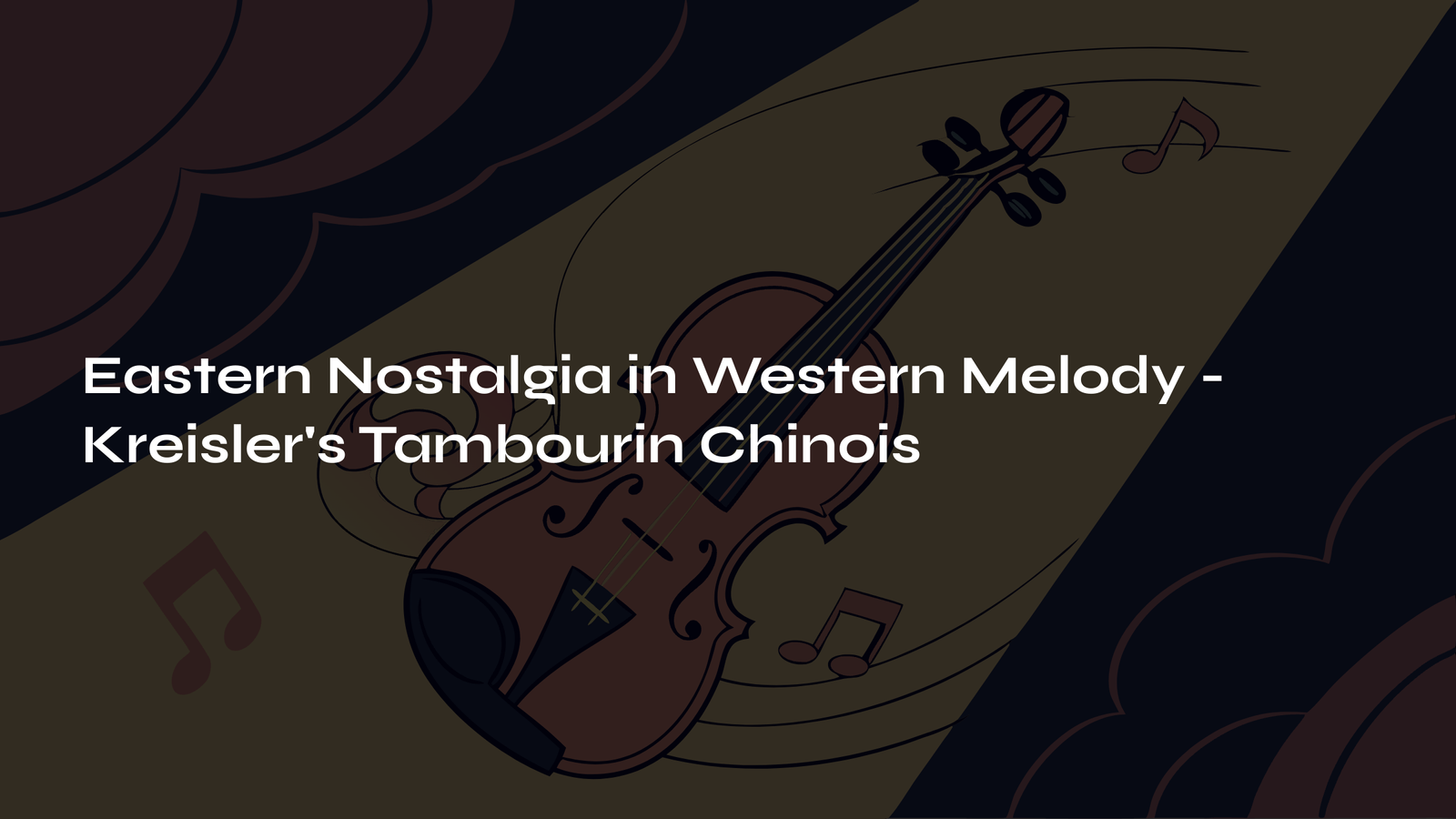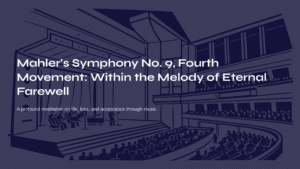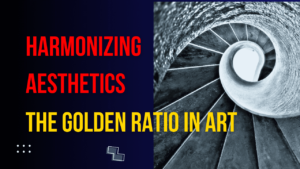Table of Contents
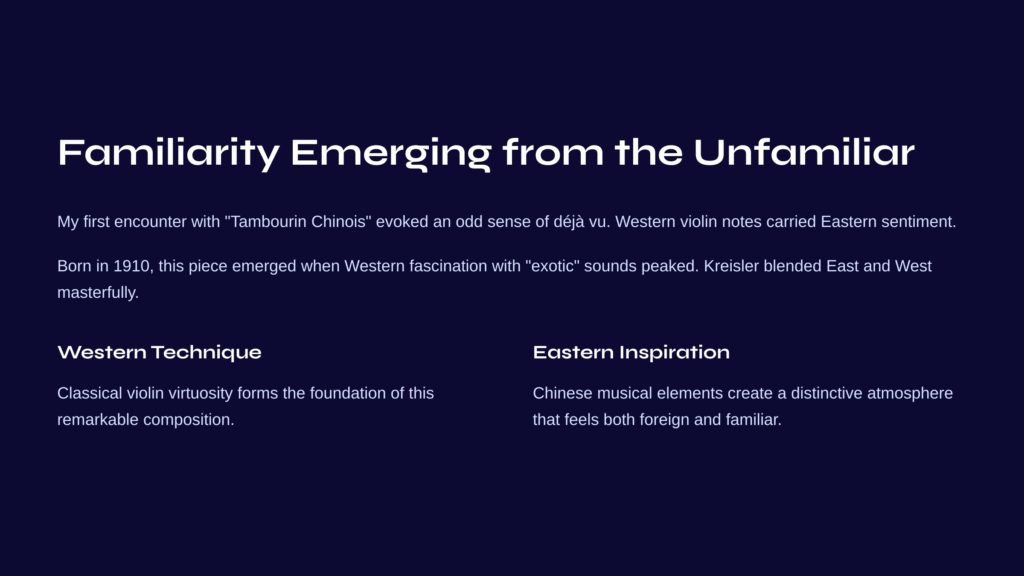
Familiarity Emerging from the Unfamiliar
When I first heard Kreisler’s “Tambourin Chinois,” I was struck by an odd sense of déjà vu. Though unmistakably a Western violin creating these melodies, something within them carried the familiar essence of Eastern sentiment. It felt as though a melody heard long ago in dreams had somehow materialized into reality—a truly mystical experience.
This piece was born in 1910, during an era when Western music’s fascination with the “exotic” reached its zenith. Yet beyond merely borrowing Eastern elements, Kreisler wove together the musical languages of East and West in his own distinctive way. The result is this brief but intense four-minute journey.
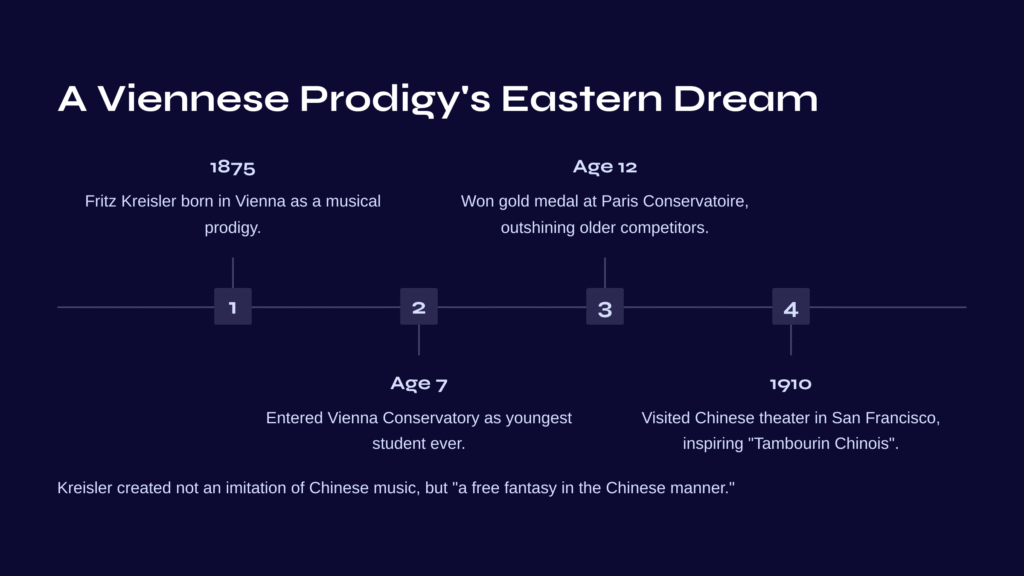
A Viennese Prodigy’s Eastern Dream
Fritz Kreisler was born in Vienna in 1875, a musical prodigy of extraordinary talent. At seven, he entered the Vienna Conservatory as its youngest student ever, and at twelve, he won the gold medal at the Paris Conservatoire, outshining forty competitors who were all at least twenty years old. His playing was renowned for its sweet tone and expressive phrasing, with his masterful use of portamento and rubato becoming his signature.
The genesis of “Tambourin Chinois” is particularly fascinating. In 1910, after visiting a Chinese theater in San Francisco, Kreisler found inspiration in traditional Chinese musical performances. However, he later explained: “The music there didn’t suggest any specific theme, but it gave me the impulse to write a free fantasy in the Chinese manner.” In essence, this work represents not an imitation of actual Chinese music, but rather a Western imagination of the Orient.
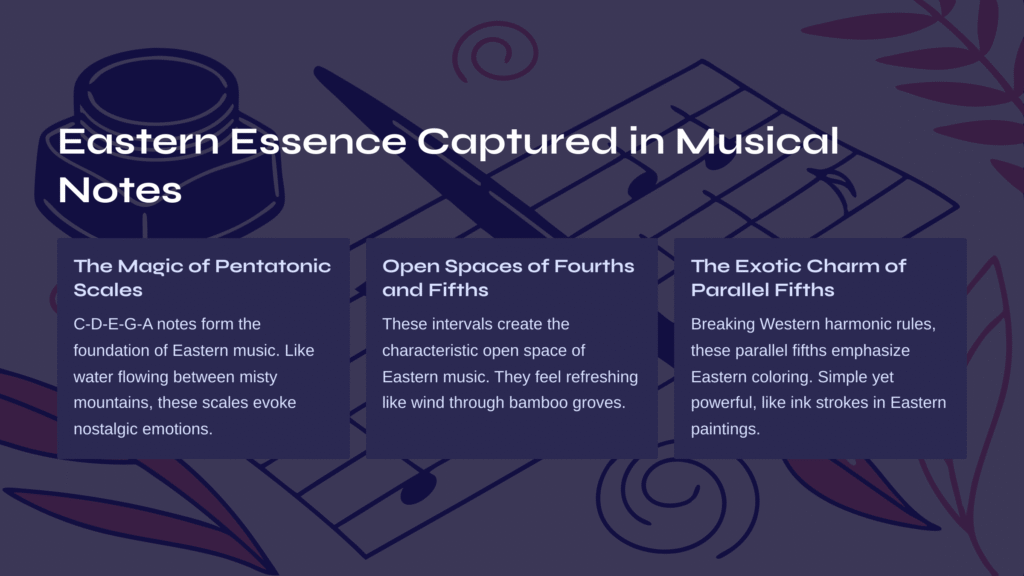
Eastern Essence Captured in Musical Notes
The Magic of Pentatonic Scales
The most distinctive feature of “Tambourin Chinois” is its extensive use of the pentatonic scale. Composed of the notes C-D-E-G-A, this scale forms the foundation of Eastern music, and through it, Kreisler created his Oriental atmosphere. Like the sound of water flowing between misty mountain peaks, this scale evokes emotions that feel somehow nostalgic and familiar.
Open Spaces of Fourths and Fifths
The intervals of fourths and fifths that appear throughout the work create the sense of open space characteristic of Eastern music. This represents an aesthetic of empty space quite different from the dense harmonies of Western music. These intervals, unfolding across the violin’s strings, feel as refreshing and free as wind blowing through a bamboo grove.
The Exotic Charm of Parallel Fifths
The occasional parallel fifths deliberately break from traditional Western harmonic rules, further emphasizing the Eastern coloring. Like the ink strokes in traditional Eastern paintings, they are simple yet leave a powerful impression.
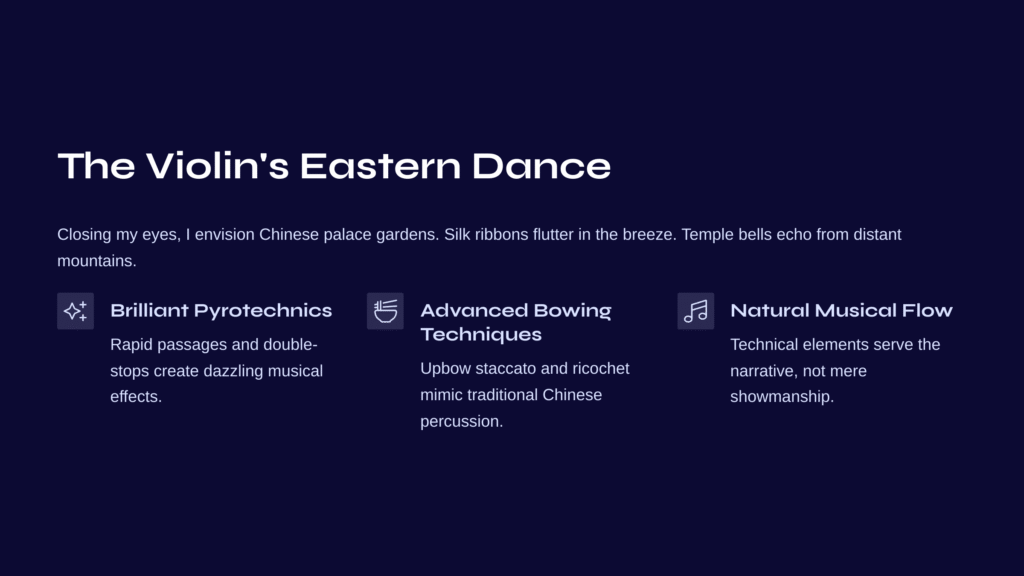
The Violin’s Eastern Dance
Listening to this piece, I often close my eyes and let my imagination wander. I envision elegant dances in Chinese palace gardens, silk ribbons fluttering in the breeze, and the distant sound of temple bells echoing from far mountains. Kreisler’s violin compresses all of these images into four brief but magical minutes.
Particularly striking are the brilliant pyrotechnics created by rapid passages and double-stops. Advanced bowing techniques like upbow staccato and ricochet weave together, seemingly mimicking the rhythms of traditional Chinese percussion instruments. Yet this isn’t mere technical showmanship—these elements flow naturally as part of the musical narrative.
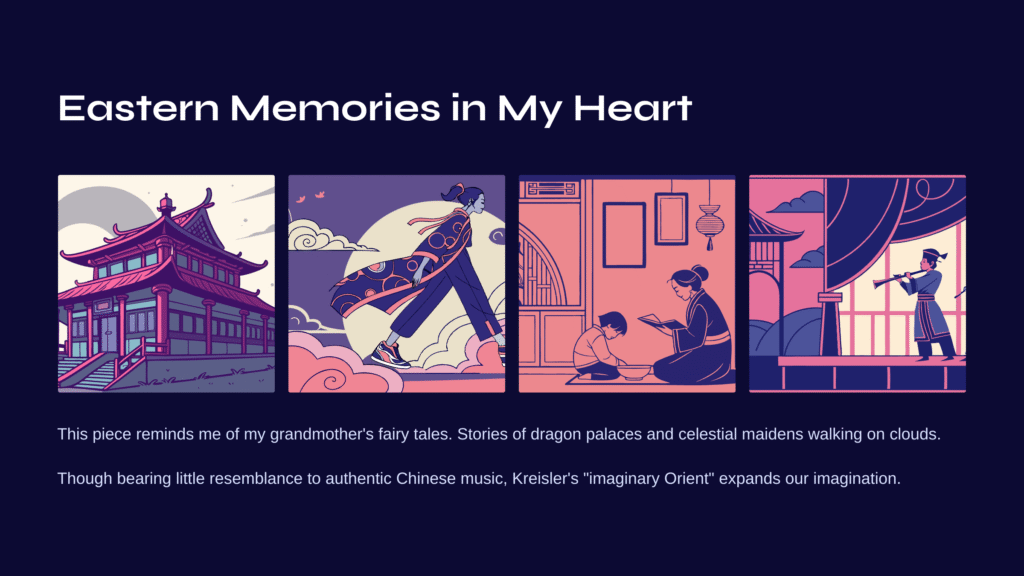
Eastern Memories in My Heart
When I first heard this piece, I was reminded of the fairy tales my grandmother used to tell me as a child. Stories of mystical events in dragon palaces, tales of celestial maidens walking on clouds… Kreisler’s “Tambourin Chinois” seemed to tell exactly such stories through music.
Of course, I’m aware that this work bears little resemblance to authentic Chinese music. It’s a product of early 20th-century Western Orientalism—the Western fantasy of the East. But this doesn’t diminish the music’s beauty. Rather, Kreisler’s creation of this “imaginary Orient” allows listeners to freely expand their own imaginations.
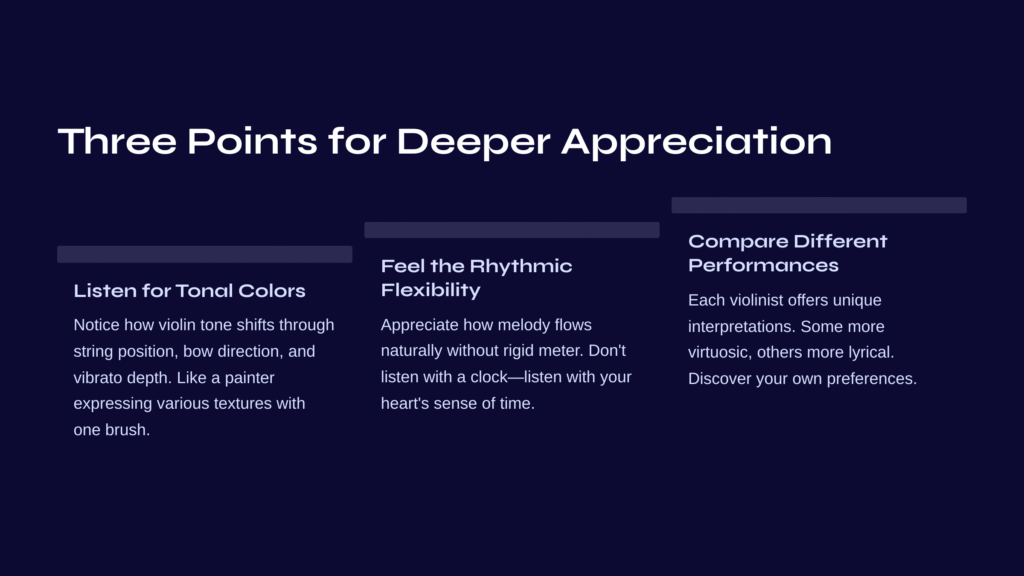
Three Points for Deeper Appreciation
1. Listen for Tonal Colors
Pay close attention to how the violin’s tone colors shift and change. Kreisler creates entirely different hues from the same melody through variations in string position, bow direction, and vibrato depth. It’s like watching a painter express various textures with the same brush.
2. Feel the Rhythmic Flexibility
One of the most captivating elements of this work is its rhythmic freedom. The melody flows naturally without being constrained by rigid meter, displaying the characteristic ease of Eastern music. Don’t listen with a clock in mind—listen with your heart’s sense of time.
3. Compare Different Performances
This masterpiece has been performed by many violinists. It’s fascinating to compare how each artist offers different interpretations. Some performances are more virtuosic, others more lyrical. Feel these differences and discover your own preferences.
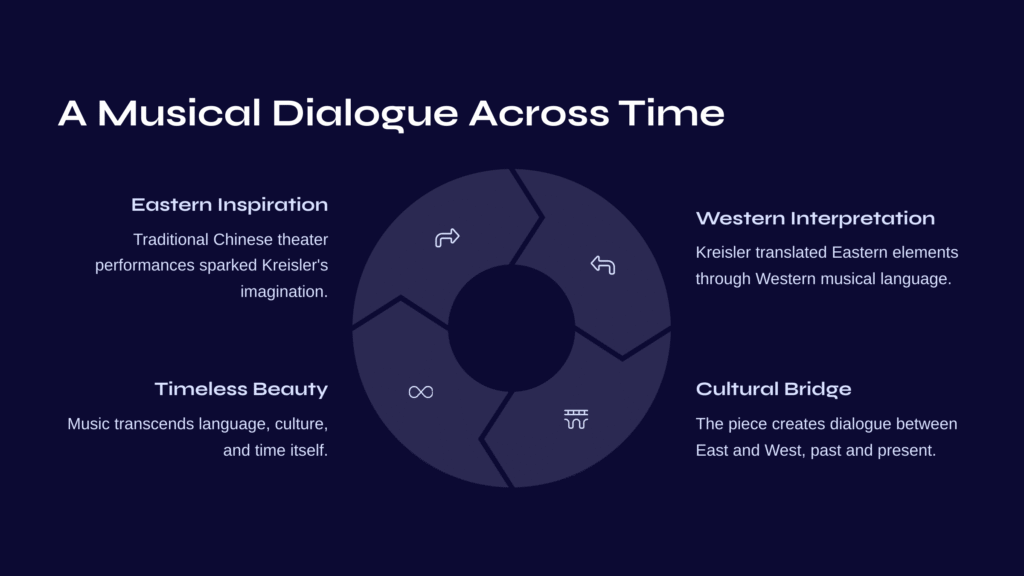
A Musical Dialogue Across Time
Kreisler’s “Tambourin Chinois” is not simply an imitation of Eastern music. It represents a musical dialogue that breaks down barriers between East and West, past and present, reality and imagination. Even if this dialogue was one-sided and sometimes based on misunderstanding, it contains genuine curiosity and reverence for other cultures.
When we listen to this work today, we experience more than just beautiful melodies. We witness how an artist’s imagination can create beauty that transcends time and space. In that moment, we all share in the mysterious wonder that Kreisler felt in that San Francisco Chinese theater.
Music transcends language, transcends culture, and even transcends time itself. “Tambourin Chinois” is a perfect example of such musical magic.
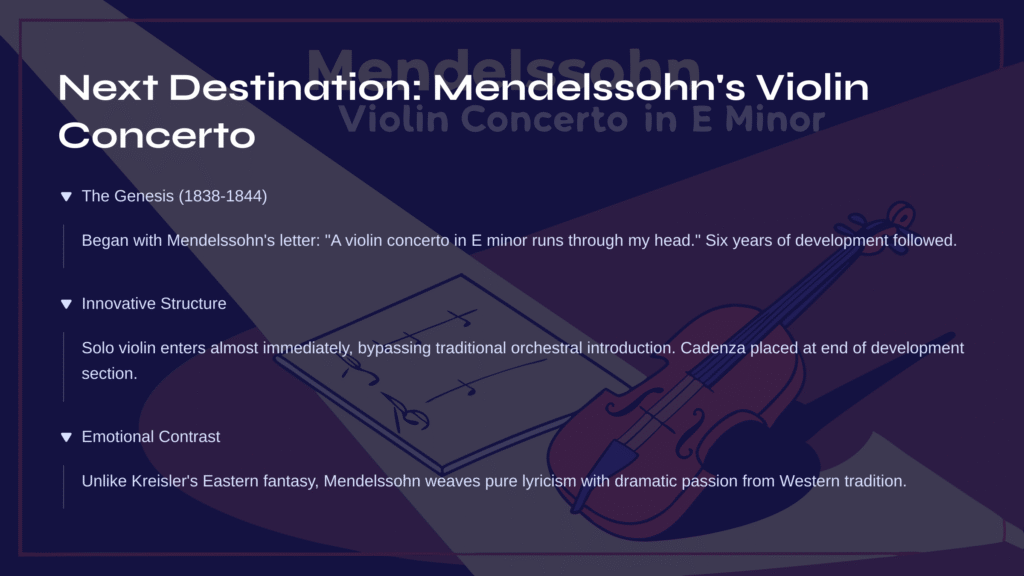
Next Destination: Mendelssohn’s Violin Concerto, First Movement
Having experienced the mystical Eastern atmosphere, why not now explore the essence of Western Romantic music? The first movement “Allegro molto appassionato” of Mendelssohn’s Violin Concerto in E minor, Op. 64, offers a completely different kind of charm from Kreisler’s work.
This composition began with a letter Mendelssohn wrote to his violinist friend Ferdinand David in 1838: “A violin concerto in E minor runs through my head, the beginning of which gives me no peace.” After six years of careful development, this masterpiece finally came to life.
The most innovative aspect of this concerto is the almost immediate entrance of the solo violin, bypassing the traditional orchestral tutti. Like a melody flowing directly from the depths of our hearts, the violin sings that famous theme over gentle string accompaniment.
Unlike Kreisler’s Eastern fantasy, Mendelssohn wove together pure lyricism with dramatic passion. His innovation of placing the cadenza at the end of the development section rather than in its traditional final position inspired many later composers, including Tchaikovsky and Sibelius.
If the exotic atmosphere of “Tambourin Chinois” touched your heart, Mendelssohn’s concerto will offer the pure emotion that bloomed within Western musical tradition. Both works demonstrate the infinite expressive power of the violin, but one moves us through curiosity about other cultures, while the other touches us through the deep roots of its own tradition.
